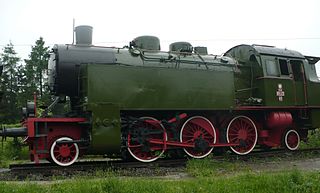
PKP class OKl27 is a class of ordinary passenger (O) tank (K) 2-6-2 (l) steam locomotives designed in 1927 for Polskie Koleje Państwowe. It was the first completely Polish construction. The design was prepared by eng. Bryling.

The DB Class 66 was a class of two Deutsche Bundesbahn (DB) locomotives designed for fast goods train and passenger train services on the main and branch lines of Deutsche Bundesbahn (DB), the national railway of the former West Germany.

The two-cylinder, superheated Bavarian Pt 2/3 engine was built by Krauss for the Royal Bavarian State Railways between 1909 and 1915. With its characteristic design - a carrying axle placed well to the front and two coupled axles at the rear under the outer firebox they asserted themselves over the rival Bavarian Pt 2/4 N and H classes and, after the demand fell for the services for which they were originally designed, they continued to be operated well into the 1960s on south German branch lines.

The DRG Class 86 was a standard goods train tank locomotive with the Deutsche Reichsbahn-Gesellschaft. It was intended for duties on branch lines and was delivered by almost all the locomotive building firms working for the Reichsbahn. From 1942 it was built in a simplified version as a 'transitional war locomotive'. The most obvious changes were the omission of the second side windows in the cab and the solid disc carrying wheels.

The Bavarian Class D XII steam locomotives were manufactured by the firm of Krauss from 1897 for the Royal Bavarian State Railways. Ninety six of them were procured for service on the stub lines running from Munich into the mountains, but in reality they were stationed in many large Bavarian locomotive depots. Two engines were transferred to the Palatinate Railway (Pfalzbahn) in 1916, the remaining 94 later joined the Deutsche Reichsbahn fleet and were incorporated as DRG Class 73.0-1 with operating numbers 73 031–124.
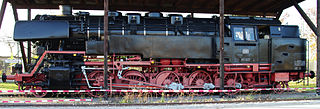
The Class 85 was a German goods train tank engine and standard locomotive (Einheitslok) with the Deutsche Reichsbahn.
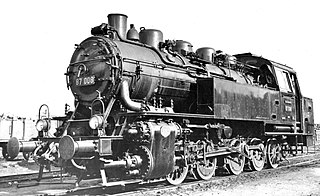
The German Class 87 was a standard goods train tank locomotive with the Deutsche Reichsbahn-Gesellschaft (DRG). It was specifically designed by the firm of Orenstein & Koppel for use in Hamburg Harbour. The harbour lines had minimal curve radii of only 100 metres (330 ft) and high train loads to be moved. The axle load had to be no more than 17.5 tonnes. These requirements resulted in an axle count of five axles. In order to keep wear and tear on the running gear within acceptable limits only the middle three wheelsets were linked by coupling rods, the two Luttermöller outside axles were driven by cogs.

The DRG Class 89.0 was a goods train tank engine of standard design built for the Deutsche Reichsbahn (DRG).
The German DRG Class 71.0 was a 2-4-2T locomotive with the Deutsche Reichsbahn, which was intended as a replacement for railbuses. Originally it had been planned for these standard engines (Einheitsloks) to haul fast passenger trains.

The Prussian T 18 was the last class of tank locomotives developed for the Prussian state railways. They were originally intended for services on the island of Rügen as replacements for Class T 12 and T 10 engines. They emerged when a class of locomotive was conceived in 1912 that was to handle express and passenger trains in border areas or in shuttle services on short routes. A tank engine design with symmetrical running gear was envisaged because, unlike a tender locomotive, it could run equally fast forwards and backwards and could be operated on return journeys without having to be turned on a turntable. Its power and top speed were to be the same as those of the P 8. Robert Garbe designed this 4-6-4 (2′C2′) tank locomotive for 100 km/h with a 17-ton axle load and contracted the Vulkan Werke in Stettin to build it. It was given the designation T 18.
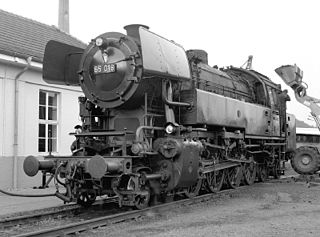
The steam locomotives of DB Class 65 were newly designed, German, passenger train tank locomotives, built for the Deutsche Bundesbahn after the Second World War. They were intended for suburban and commuter trains serving German cities, where they were to replace Classes 78 and 93.5. As a result, they were allocated to the locomotive depots at Darmstadt, Düsseldorf and Letmathe. Between Düsseldorf and Essen they were even used on early S-Bahn services. And between Limburg/Lahn and Wiesbaden and in the area of Darmstadt they also hauled goods trains.

The DB Class 82 was a goods train tank locomotive with the Deutsche Bundesbahn in Germany, that was built in the period after the Second World War and was intended for shunting and normal rail services. They were to replace the ten-coupled state railway (Länderbahn) engines and also the accident-prone Class 87 DRG Einheitslok.

The DR Class 65.10 was a class of 2-8-4 passenger train tank engine operated by the East German Deutsche Reichsbahn (DR) for heavy suburban and commuter services.
The DR Class 83.10 was a newly designed (Neubaulok) steam locomotive built for the Deutsche Reichsbahn in East Germany after the Second World War and was introduced into service in 1955 and 1956.

The Mecklenburg T 4 was a German steam locomotive built for the Grand Duchy of Mecklenburg Friedrich-Franz Railway as a goods train 2-6-0T with a leading axle and three coupled axles. In 1925 it was incorporated in the renumbering plan of the Deutsche Reichsbahn as DRG Class 91.19.

Locomotive numbers 1 to 3 on the Lübeck-Büchen railway in Germany were streamlined tank locomotives. The locomotives had a 2-4-2T wheel arrangement, a two-cylinder, superheated engine and were capable of push-pull operations. In order to ensure a symmetrical running gear, both carrying axles were built as Bissel bogies, which were fitted with return devices for improved running.
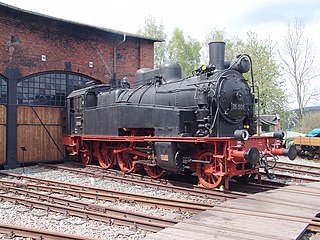
The Saxon Class XIV T locomotives were six-coupled tank engines operated by the Royal Saxon State Railways for mixed duties on main and branch lines. In 1925, the Deutsche Reichsbahn grouped them into their DRG Class 75.5.
The Prussian T 9 was a class of German steam locomotive which included several types of tank engine, all with six coupled wheels and two carrying wheels operated by the Prussian state railways.

The Prussian Class T 12 were early German passenger tank locomotives built for the Prussian state railways in large numbers. These locomotives were superheated variants of the T 11.

The Prussian T 8 were six-coupled superheated goods tank locomotives of the Prussian state railways. They were originally intended for suburban passenger service in Berlin, and for use on branch lines. Due to their poor running qualities, they were demoted to shunting and short-distance goods train service.
















